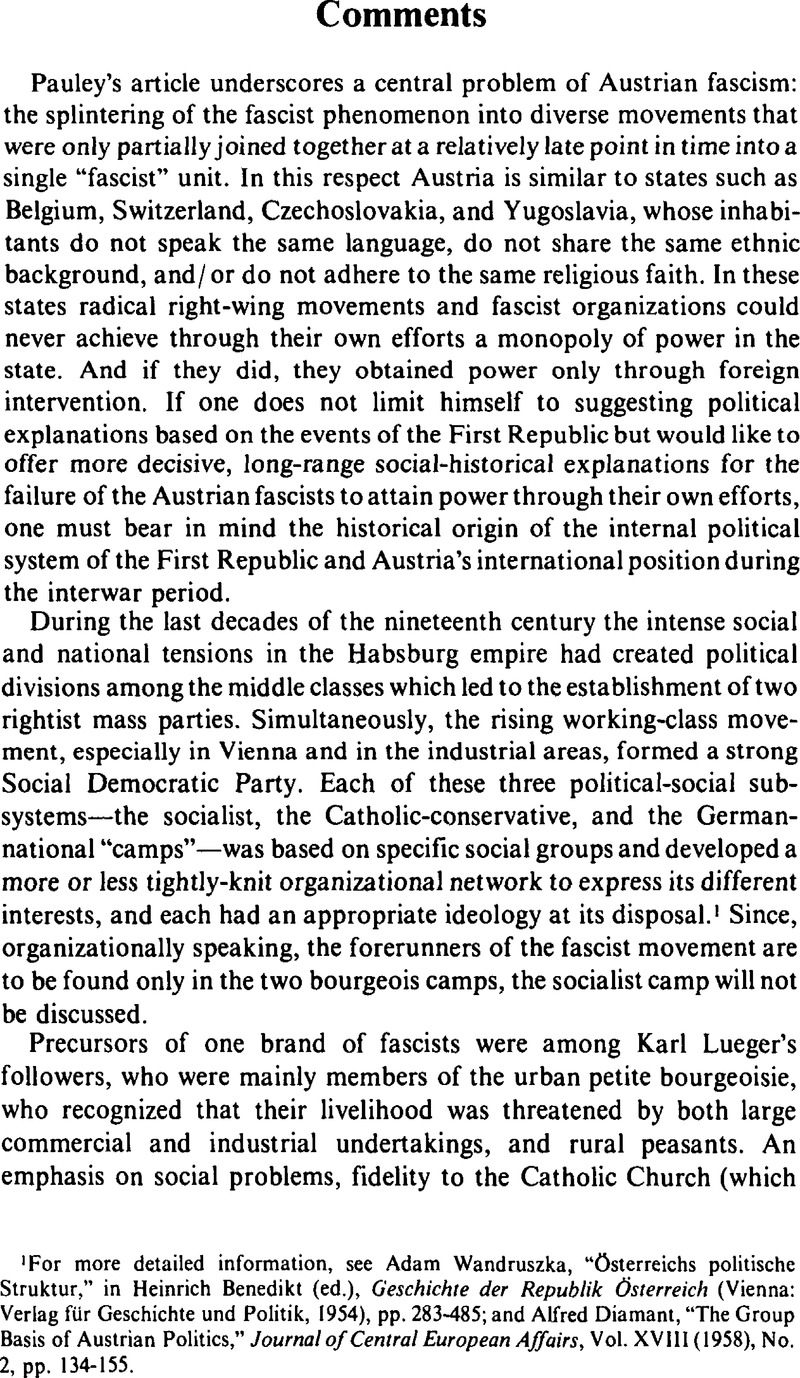No CrossRef data available.
Published online by Cambridge University Press: 10 February 2009

1 For more detailed information, see Wandruszka, Adam, “Österreichs politische Struktur,” in Benedikt, Heinrich (ed.), Geschichte der Republik Österreich (Vienna: Verlag für Geschichte und Politik, 1954), pp. 283–485Google Scholar; and Diamant, Alfred, “The Group Basis of Austrian Politics,” Journal of Central European Affairs, Vol. XVIII (1958), No. 2, pp. 134–155Google Scholar.
2 See Jedlicka, Ludwig, Vom alten zum neuen Ösierreich. Fallstudien zur Österreichischen Zeitgeschichte 1900–1975 (St. Pölten: Niederösterreichisches Pressehaus, 1975)Google Scholar; and Stadler, Karl R., “Austria,” in Woolf, Stuart J. (ed.), European Fascism (London: Weidenfeld and Nicolson, 1968), pp. 88–110Google Scholar.
3 We are deliberately not going into the general causes of fascism here. For excellent discussions of fascist theories relevant to Austria, see Klingenstein, Grete, “Bemerkungen zum Problem des Faschismus in Österreich,” Österreich in Geschichte und Literatur, Vol. XIV, No. 1 (January, 1970), pp. 1–13Google Scholar; Hanisch, Ernst, “Neuere Faschismustheorien,” Zeitgeschichte, Vol. I, No. 1 (October, 1973), pp. 19–23Google Scholar; and Rath, R. John, “The First Austrian Republic–Totalitarian, Fascist, Authoritarian, or what?” in Neck, Rudolf and Wandruszka, Adam (eds.), Beiträge zur Zeitgeschichte. Festschrift Ludwig Jedlicka zum 60. Geburtstag (St. Pölten: Niederösterreichisches Pressehaus, 1976), pp. 163–188Google Scholar.
4 For a more detailed discussion, see my articles on “Faschismus und Lohnabhängige in der Ersten Republik,” in Österreich in Geschichte und Literatur, Vol. XXI, No. 2 (March-April, 1977), pp. 102–128Google Scholar; and “Varieties of Fascism in Austria: A Survey of Findings,“ in Larsen, Stein U., Hagtvet, Bernt, and Myklebust, Jan Petter (eds.), Who were the Fascists? Social Roots of European Fascism, which will be published in New York in 1978 by Columbia University PressGoogle Scholar.
5 See especially Jagschitz, Gerhard, Der Putsch. Die Nationalsozialisten 1934 in Österreich (Graz: Styria, 1976)Google Scholar; and Jedlicka, Ludwig and Neck, Rudolf (eds.), Vom Justizpalast zum Heldenplatz. Studien und Dokumentationen 1927 bis 1938 (Vienna: Österreichische Staatsdruckerei, 1975)Google Scholar.
6 Pauley, Bruce F., Hahnenschwanz und Hakenkreuz. Der steirische Heimatschutz und der Österreichische Nationalsozialismus 1918–1934 (Vienna: Europa Verlag, 1972)Google Scholar.
7 Among them the most recent is a comprehensive history of the Austrian fascist movements by Carsten, Francis L.. See his Fascist Movements in Austria: From Schönerer to Hitler (London: Sage Publications, 1976)Google Scholar.
8 See ante, p. 261.
9 See ante, p. 262.
10 See ante, p. 258.